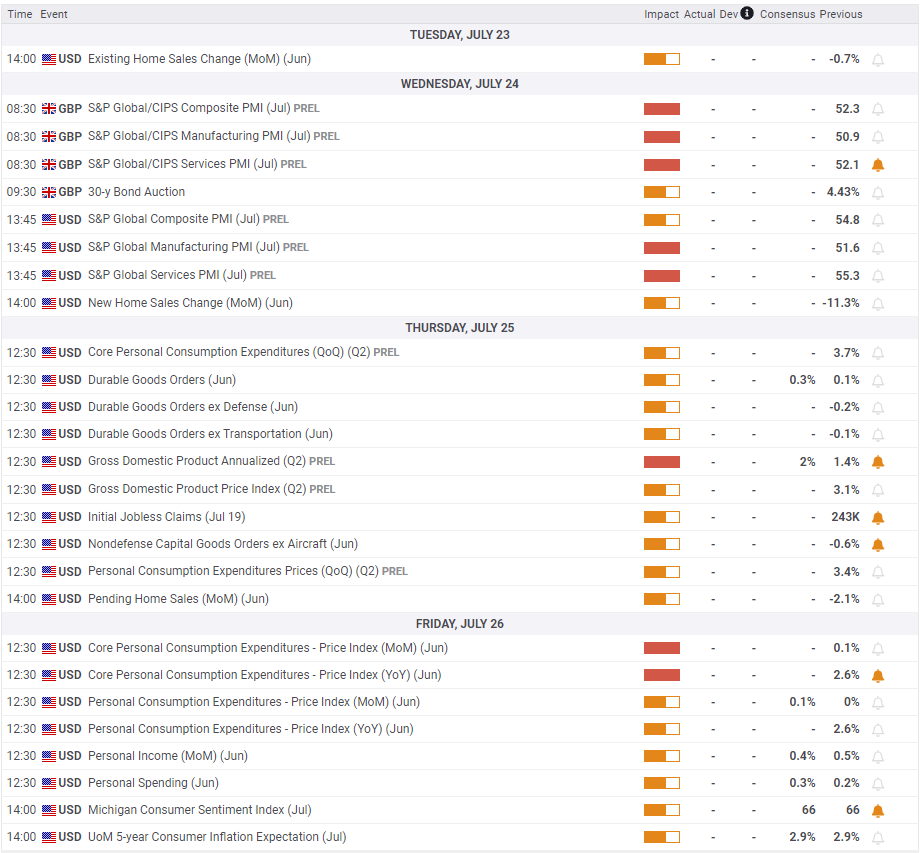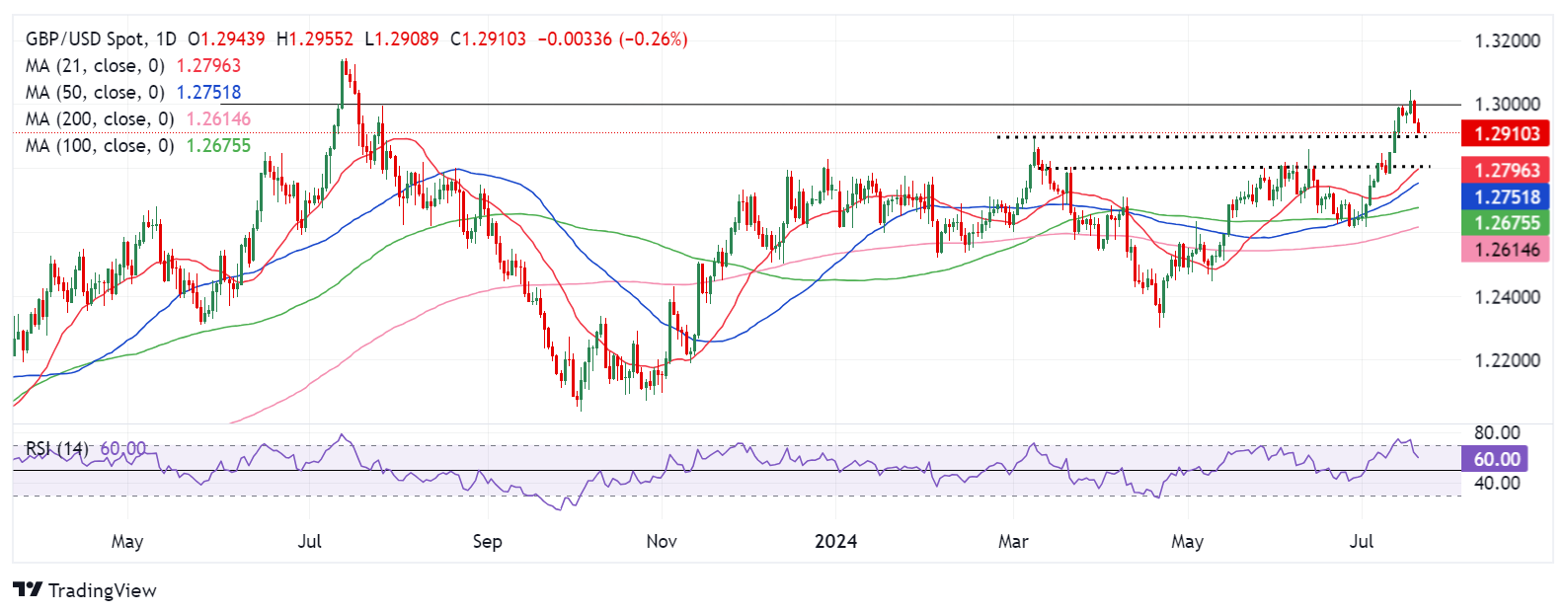- The Pound Sterling reached its highest level in a year versus the US Dollar, 1.3050 tested.
- GBP/USD appears to be a ‘buy-the-dips’ trade in the action-packed week ahead.
- Pound Sterling reverses from the overbought zone, implying more upside going forward.
The Pound Sterling (GBP) recorded a fresh 12-month high above 1.3000 against the US Dollar (USD) but the GBP/USD pair snapped its two consecutive weekly gains to settle in the red.
Pound Sterling briefly recaptured the key 1.3000 mark
Even though monetary policy divergence between the US Federal Reserve (Fed) and the Bank of England (BoE) remained the dominant factor driving the GBP/USD price action, the late comeback by the USD on broad risk aversion spoilt the party for the Pound Sterling.
GBP/USD extended the previous week’s upsurge and hit the highest level since July 2023 at 1.3045 after the UK Consumer Price Index (CPI) inflation bolstered expectations that the BoE would refrain from cutting interest rates in August. The UK CPI rose 2.0% in the year to June, having increased by 2.0% in May, according to the data released by the Office for National Statistics (ONS) on Wednesday, aligning with the market consensus while staying at the BoE’s 2.0% target. The sticky Services CPI inflation held steady at 5.7% YoY in the same period.
Meanwhile, markets fully priced in a September Fed rate cut, in light of softer inflation readings from the US and dovish Fed commentaries, especially the one from Chairman Jerome Powell. Powell said on Monday that the central bank will not wait until inflation hits 2% to lower interest rates. His appearance was the last one before the Fed entered its ‘blackout period’, fuelling a big market reaction.
The tide, however, turned in favor of the US Dollar buyers, helping the Greenback stage an impressive comeback in the latter part of the week. Wall Street witnessed a significant sell-off, as traders rotated away from high-priced megacap growth stocks amid the second-quarter earnings season. Further, escalating US-China trade tensions also aggravated risk-off sentiment, as markets remained wary of a further worsening of trade relations under a potential Donald Trump’s US presidency. A report that the US was considering tighter curbs on exports of advanced semiconductor technology to China sent chip stocks and the Nasdaq tumbling, per Reuters.
Resurgent US Dollar demand fuelled a sharp correction in the GBP/USD pair, sending it back under the 1.3000 threshold. Meanwhile, the UK labor market report showed Thursday that wage growth slowed to its lowest pace in nearly two years for the three months through May. The Unemployment Rate held steady at 4.4% in May, as anticipated. The wage inflation data prompted investors to ponder about the August rate cut, exerting additional downside pressure on the Pound Sterling.
The weak UK Retail Sales report also added to the gloom surrounding the GBP/USD pair. Retail Sales dropped 1.2% over the month in June after rebounding 2.9% in May, the latest data published by the ONS showed Friday. Markets projected a 0.4% decline in the reported month. The core Retail Sales, stripping the auto motor fuel sales, declined by 1.5% MoM, against the previous jump of 2.9% and the estimated -0.5% print.
Week ahead: A busy UK and US calendar
With the critical UK economic releases out of the way, US statistics will likely hog the limelight in the week ahead, impacting the GBP/USD price action.
It’s a typical quiet start to a big week, filled with high-impact in the second half. Monday is devoid of any important macro releases from both sides of the Atlantic. Therefore, speculations surrounding the Fed and BoE interest rate expectations and potential trade concerns will continue to have a pivotal role.
The mid-tier US Existing Home Sales is the only relevant data due on Tuesday. However, Wednesday will feature the preliminary S&P Global Manufacturing and Services PMI data from the UK and the US.
Meanwhile, the advance second-quarter Gross Domestic Product (GDP) data from the US will grab the eyeballs on Thursday. Markets will also look to the weekly Jobless Claims and Durable Goods Orders data that will be released parallelly that day.
The focus will then shift to Friday’s US core Personal Consumption Expenditures (PCE) Price Index, the Fed’s preferred inflation gauge, which will provide fresh cues on the interest rate outlook amid the Fed ‘blackout period’.
GBP/USD: Technical Outlook
Following a brief attempt to penetrate the 1.3000 level, the Pound Sterling continues to remain as a ‘buy-dips’ trade, as observed on the GBP/USD daily chart.
The 14-day Relative Strength Index (RSI) has reversed from the overbought territory to trade near 64, at the press time, suggesting that the upside risks remain intact.
However, if the GBP/USD correction from the 2024 highs gathers steam, the immediate cushion is seen at the throwback support from the March 8 high of 1.2894.
A sustained move below the latter will challenge the bullish commitments at the previous key resistance near 1.2800. At that level, the 21-day Simple Moving Average (SMA) converges.
Further south, the 50-day SMA at 1.2751 will be tested. Additional declines will call for a test of the June low of 1.2613.
On the upside, recapturing the 1.3000 key level on a weekly closing basis is critical to reviving the uptrend toward the yearly high of 1.3045.
If buyers gain a strong foothold above that level, a fresh run to the 1.3100 round figure and beyond cannot be ruled out.
Pound Sterling FAQs
The Pound Sterling (GBP) is the oldest currency in the world (886 AD) and the official currency of the United Kingdom. It is the fourth most traded unit for foreign exchange (FX) in the world, accounting for 12% of all transactions, averaging $630 billion a day, according to 2022 data. Its key trading pairs are GBP/USD, aka ‘Cable’, which accounts for 11% of FX, GBP/JPY, or the ‘Dragon’ as it is known by traders (3%), and EUR/GBP (2%). The Pound Sterling is issued by the Bank of England (BoE).
The single most important factor influencing the value of the Pound Sterling is monetary policy decided by the Bank of England. The BoE bases its decisions on whether it has achieved its primary goal of “price stability” – a steady inflation rate of around 2%. Its primary tool for achieving this is the adjustment of interest rates. When inflation is too high, the BoE will try to rein it in by raising interest rates, making it more expensive for people and businesses to access credit. This is generally positive for GBP, as higher interest rates make the UK a more attractive place for global investors to park their money. When inflation falls too low it is a sign economic growth is slowing. In this scenario, the BoE will consider lowering interest rates to cheapen credit so businesses will borrow more to invest in growth-generating projects.
Data releases gauge the health of the economy and can impact the value of the Pound Sterling. Indicators such as GDP, Manufacturing and Services PMIs, and employment can all influence the direction of the GBP. A strong economy is good for Sterling. Not only does it attract more foreign investment but it may encourage the BoE to put up interest rates, which will directly strengthen GBP. Otherwise, if economic data is weak, the Pound Sterling is likely to fall.
Another significant data release for the Pound Sterling is the Trade Balance. This indicator measures the difference between what a country earns from its exports and what it spends on imports over a given period. If a country produces highly sought-after exports, its currency will benefit purely from the extra demand created from foreign buyers seeking to purchase these goods. Therefore, a positive net Trade Balance strengthens a currency and vice versa for a negative balance.
Information on these pages contains forward-looking statements that involve risks and uncertainties. Markets and instruments profiled on this page are for informational purposes only and should not in any way come across as a recommendation to buy or sell in these assets. You should do your own thorough research before making any investment decisions. FXStreet does not in any way guarantee that this information is free from mistakes, errors, or material misstatements. It also does not guarantee that this information is of a timely nature. Investing in Open Markets involves a great deal of risk, including the loss of all or a portion of your investment, as well as emotional distress. All risks, losses and costs associated with investing, including total loss of principal, are your responsibility. The views and opinions expressed in this article are those of the authors and do not necessarily reflect the official policy or position of FXStreet nor its advertisers. The author will not be held responsible for information that is found at the end of links posted on this page.
If not otherwise explicitly mentioned in the body of the article, at the time of writing, the author has no position in any stock mentioned in this article and no business relationship with any company mentioned. The author has not received compensation for writing this article, other than from FXStreet.
FXStreet and the author do not provide personalized recommendations. The author makes no representations as to the accuracy, completeness, or suitability of this information. FXStreet and the author will not be liable for any errors, omissions or any losses, injuries or damages arising from this information and its display or use. Errors and omissions excepted.
The author and FXStreet are not registered investment advisors and nothing in this article is intended to be investment advice.
Recommended Content
Editors’ Picks

USD/JPY remains below 158.00 after Japanese data
Soft US Dollar demand helps the Japanese Yen to trim part of its recent losses, with USD/JPY changing hands around 157.70. Higher than anticipated Tokyo inflation passed unnoticed.

AUD/USD weakens to near 0.6200 amid thin trading
The AUD/USD pair remains on the defensive around 0.6215 during the early Asian session on Friday. The incoming Donald Trump administration is expected to boost growth and lift inflation, supporting the US Dollar (USD). The markets are likely to be quiet ahead of next week’s New Year holiday.

Gold depreciates amid light trading, downside seems limited due to safe-haven demand
Gold edges lower amid thin trading following the Christmas holiday, trading near $2,630 during the Asian session on Friday. However, the safe-haven asset could find upward support as markets anticipate signals regarding the United States economy under the incoming Trump administration and the Fed’s interest rate outlook for 2025.

Floki DAO floats liquidity provisioning for a Floki ETP in Europe
Floki DAO — the organization that manages the memecoin Floki — has proposed allocating a portion of its treasury to an asset manager in a bid to launch an exchange-traded product (ETP) in Europe, allowing institutional investors to gain exposure to the memecoin.

2025 outlook: What is next for developed economies and currencies?
As the door closes in 2024, and while the year feels like it has passed in the blink of an eye, a lot has happened. If I had to summarise it all in four words, it would be: ‘a year of surprises’.

Best Forex Brokers with Low Spreads
VERIFIED Low spreads are crucial for reducing trading costs. Explore top Forex brokers offering competitive spreads and high leverage. Compare options for EUR/USD, GBP/USD, USD/JPY, and Gold.

